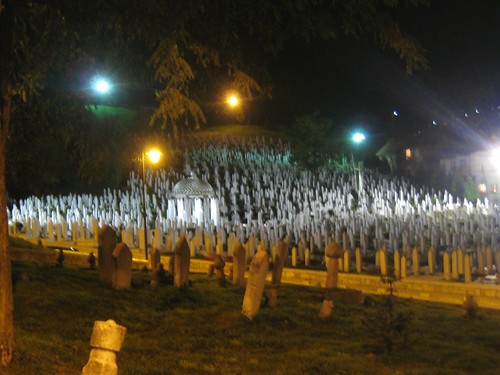Do you remember what you were doing in 1992? I do. Chances are I was folding Free People boatneck tees or Girbaud jeans on State Street in Ann Arbor. Or I might have been splitting half a large pizza with Danielle at 2am after a night out at Sigma Pi. Or maybe I was in class or just maybe I was studying. For me, life was fun and I had a worry-free young adulthood. But that wasn’t true for the rest of the world. In Bosnia & Herzegovina (BiH), the people were being traumatized by non-stop shelling. They were losing their family and friends to sniper shots. And they were attending funerals in the dark because it was too risky during the day.
Historically, Sarajevo was an important city based on it’s strategic location between the far east and Europe. There are many Turkish influences in Sarajevo as a result of 400 years of Ottoman rule–the food, the city bazaar and Islamic mosques. And after the Turks, the Austro-Hungarians ruled for 40 years before WWI leaving behind Christianity and Judaism along with religious and cultural tolerance. In 1992 Yugoslavia was formally disolved into Croatia, Serbia, Slovenia, Republic of Macedonia, Montenegro, and Bosnia & Hercogovina. However Serbia felt Bosnia & Herzegovina was rightfully their land and set out to claim it, thus the Bosnian War. Of course, there are two sides to every story, but the one I heard is tragic anyway you look at it. For 4 years between 1992-1995, Sarajevo was under siege by Serbia. During this time, Serbia attempted genocide on all non-Serbs killing 11000 people. NATO forces finally intervened and eventually pushed the Serbs out of BiH.
How could this happen to Sarajevo, a city who’s future looked so bright. In 1984 Sarajevo had the honor to host the winter Olympics, and 8 years later there was a war. There is still evidence of the destruction; burned out apartment buildings still stand, and bullet holes can be seen in many buildings. Although much of the city has been rebuilt, there are many houses that still lay dilapilated and untouched since the war. Apparently there is the question of ownership with these homes, as the city can not verify who the rightful owner is, and more importantly, if the owner is still alive after the war. So instead, these homes lay in ruins, a constant reminder of what the war did to the city and people of Sarajevo. But Bosniaks are survivors. We had an amazing tour guide, Fikret Kahrovic who lived to tell his story of Sarajevo. Fikret moves forward with unbelievable optimism. And although he claims, Bosniaks love to complain, he personally, feels he has no right to complain because it would be selfish since there is always someone who fared far worse than he did [after the war].
